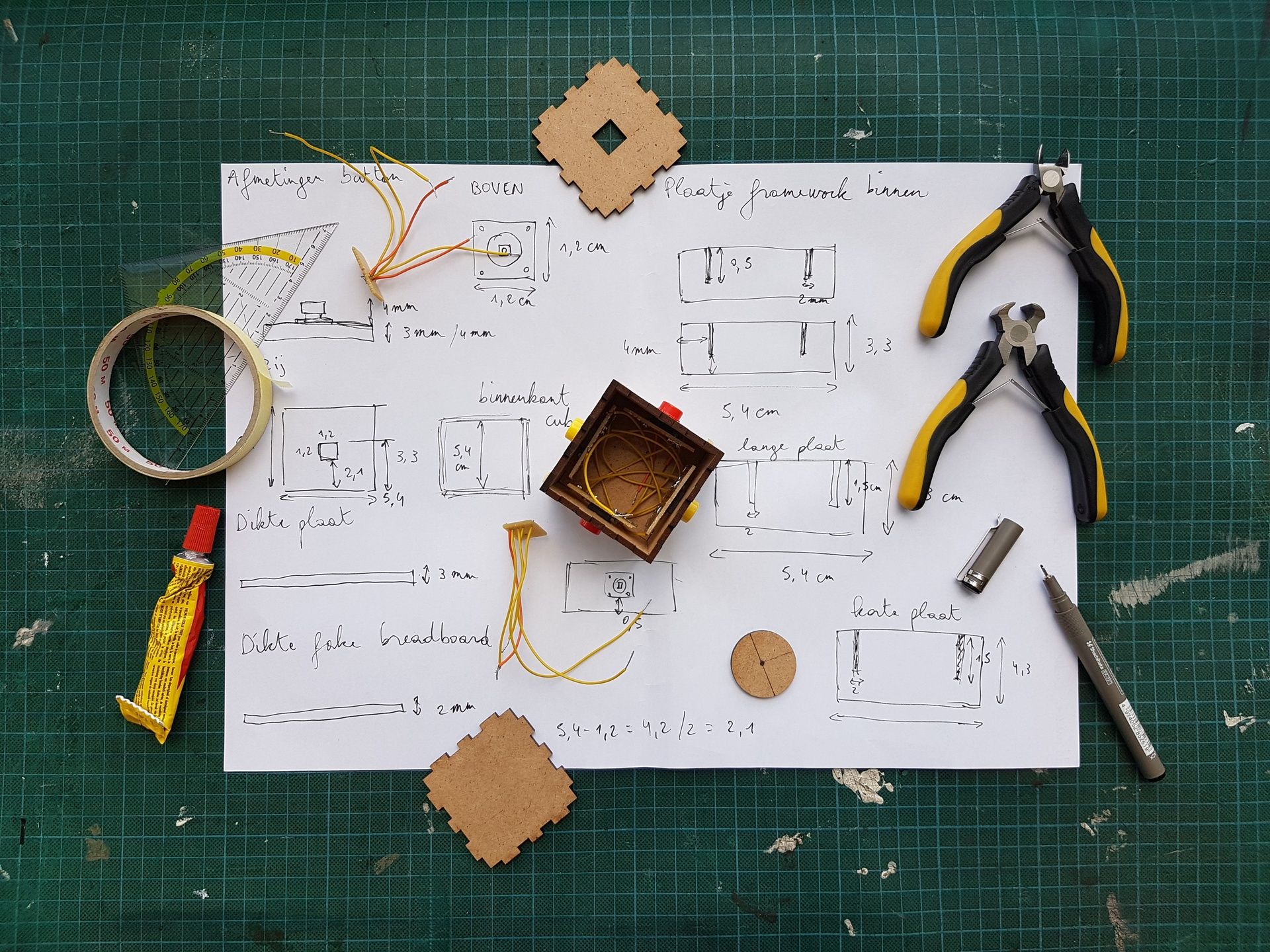Blog, Marketing, Business Planning, Sales, Product Development, Merchandising

Hiring contractors can be a tough process. There are a ton of people out there doing specialized work in a range of different fields, but it’s hard to know who’s going to fit well with the rest of your team, understand your vision, and deliver exceptional results.
For product-driven businesses, there are a few critical areas where you’ll likely be looking for outside help. With each of these different “departments,” you’ll need trustworthy, creative people that can bring your ideas to life - and failing to choose wisely can result in wasted time and money.
Fortunately, the core steps for finding, vetting, and hiring a contractor (or team) are about the same regardless of speciality. Let’s quickly review three of these essential areas, then dive into the principles you can use to hire the best fits for your business.
Graphic Design
Logos and images are usually your brand’s first impression on prospective customers. From billboards to YouTube thumbnails, the imagery you put out into the world reflects the quality and tone of your business - and that means you need an excellent graphic designer.
As you move forward into marketing, expanding your product line, offering promotions, and so on, high quality images will come into play time and time again. A reliable, knowledgeable, professional graphic designer is one of the most important parts of your team.
3D Modeling and Prototyping
Before you can bring a product to market, you need to design and prototype to determine the exact specifications of the finished result. This can be done in a variety of ways, but modern technology allows for digital modeling and 3D printing to drastically increase turnaround times and reduce material costs.
Relying on this technology, however, means hiring people that have both access and skills to bring your ideas into reality. This essential stage of product development should not be taken lightly, and that includes taking the time to find the best 3D modelers and prototyping experts for budget, target market, and projected timelines.

Marketing Team
Even with a great product, excellent graphics, and all the pieces in place to manufacture and distribute - you still need to find customers! Getting help with marketing, though, is one of more challenging areas of contractor hiring - simply because there are so many areas of expertise, so many people online selling their services, and so many ways to tackle the ongoing necessity of attracting and retaining buyers.
Your options, then, are very broad. You may find that an agency (with a whole team on deck) is the best fit, or build your own team out of individual specialties. With either approach, you’ll want to make sure you’re hiring based on a proven track record, as well as a good personality fit with your business.
Preparing
Before you begin your search, it’s important to lay some groundwork. Taking the time to define your needs, set expectations, and determine a budget will make all future communication much smoother - and help you get the results you’re after.
This goes for any kind of contractor, freelancer, or agency you may want to partner with.
Defining The Work
Even if you aren’t an expert in graphic design, prototyping, or marketing, you likely have a good idea of what you need - or at least what you’d like the final results to look like. The people you hire will know the jargon and technical requirements of the projects you assign, but the more specifics you provide, the better they’ll be able to do the job.
For example, a designer will be able to help determine specific file types, resolution requirements, and so on, but it’s up to you to provide direction and guidance.
To define what you need from a graphic designer, ask yourself the following questions:
- What colors, fonts, and other branding guidelines represent your business?
- Where will the graphics be used (website, print, social media, etc.)?
- What are the size requirements?
- Who is the target audience?
For a 3D modeler and/or prototype developer, defining the project may include size specifications (and acceptable variance), dimensions, materials you plan to use for the finished product, specific features you need the prototype to have, file types, and beyond.
Defining work for marketing teams can be a little bit murkier, since ideal outcomes are usually broad requests for more qualified leads, reaching a wider audience, and making more sales. Still, the more concrete goals you can provide about reach, lead generation, and other metrics, the more accurately a marketing team will be able to point their efforts.
Beyond defining the specifics of the work (whether it’s graphic design, digital modeling, prototyping, marketing collateral, or overall marketing strategy), it’s also important to consider the scope of the work. Is this a one-time project? An ongoing relationship? If the work is ongoing, is it part-time or full-time?
Ask yourself these questions at the outset of each project and have the answers on hand as you begin to consider candidates for hire. Having information up front helps everyone get on the same page that much faster. Even if you don’t know every detail, every bit of defining information helps!

Expectations
While this information might change as you find the right contractors and engage in discussions, you can still ballpark your expectations at the beginning of your search. Such expectations might include project timelines, how often you check in (or vice versa), points of contact, method of communication, rates, and beyond.
This also extends into the technical side of things, such as file formats, source files, model tolerances, resolution, RGB vs. CMYK, marketing platforms, social media metrics, ROI, project management systems, and on and on...
If you aren’t sure about these technical aspects, communicate that clearly to your candidates and use their responses as another method of vetting.
Again, these expectations should be a bit flexible. If you find a designer whose work you love, who fits your budget, and communicates well, perhaps you can adjust your timeline. If a 3D modeler can meet your turnaround times and has a reputation for excellence, it might be worth paying their higher rates. Initial conversations with marketers could change your opinions about what platforms to focus on...
Instead of setting exact rules and only considering candidates that fit neatly into that box, give your expectations a bit of wiggle room, and use them as talking points with potential contractors to gauge how well they’ll fit. Not only are you looking for skilled, professional people to work with - you also want people willing to share their expertise to guide you and your product in the right direction.
Budget
Amazing work usually doesn’t come cheap. Consider your project carefully, and do some research about rates for various types of graphic design, prototyping, and marketing work, from assembling existing pieces to full design from scratch. You can explore freelance rates through online platforms, ask your colleagues what they’re paying for similar services, and as you begin to have exploratory conversations with candidates, keep notes about how much they charge so you can compare them later.
Once you have an idea of how much your project will cost, you can look at your own finances to determine how much you can spend - which may also influence your expectations about timelines and frequency of work.
Armed with these two sides of the budget coin, you can rule out candidates that are both too expensive and wildly below your projected expense. It may be tempting to go with the cheapest option, but you’ll likely sacrifice quality if you do. You don’t need to go with the most expensive option either, but be realistic about the importance of great graphics, functional prototypes, and expert marketing… And set your budget accordingly.
Searching
Once you’ve defined the work, set some expectations, and clarified a budget, it’s time to begin your search! You can go about finding people to work with in a variety of ways, and it may take a combination of approaches to find the right fit.
Referrals
The best way to find a skilled, trustworthy contractor is by asking your network for referrals. Start with people you know, especially others in your industry who have fantastic graphics on their website, beautiful print materials, compelling marketing campaigns, and great products.
This request for referrals can extend out to the rest of your professional network, friends and family, even to social media posts. While you can pretty easily find people doing graphics work and marketing for hire online, 3D modelers and prototyping experts may be harder to come by through online search alone.
Whether the available pool of talent is large or small, a personal recommendation from someone you trust saves a ton of time in the vetting process.
When someone makes a referral, it means they’re already happy with the results, work ethic, communication, and everything else that makes them an excellent hire.

Job Sites
If you can’t find an ideal contractor through a trusted referral, the next step is to turn to online job sites. Your options here are numerous, but don’t get overwhelmed! Start with one site, and if you don’t find what you’re looking for, move to the next.
Some sites cater to freelancers of all kinds, while others are more industry specific. It’s worth noting that 3D modeling and prototype development are niche industries - and that means there aren’t platforms/job sites dedicated to such services. For this part of building your product-driven business, look to the general contractor sites and google searches for modeling and prototyping agencies for hire.
With that caveat in mind, here are some of the most popular job site options arranged by category:
General
Graphic Design
Marketing
Each of these sites (and numerous others) have their own models for pricing, search, and communication, but are all worth exploring for their various strengths and niches. A word of warning about Fiverr: there are sometimes add-on fees that raise the initial cost, and because of the platform’s focus on low-price, entry level work, it might be difficult to find more advanced freelancers, regardless of the service you’re looking for.
As you go through these job sites, keep your expectations and budget in mind. You can quickly exclude candidates that aren’t even in the ballpark, and narrow the field to your favorites before moving on to the next steps.
Portfolio Review
Once you’ve gathered a pool of viable candidates, it’s time to do a deep dive on portfolios and example work. You likely reviewed some of each candidate’s work as you gathered potential hires, but you’ll want to take a closer look before you make any kind of official decision.
Of course you’re looking for quality first and foremost, but there are other factors to consider as well. Even the best contractor with the most skill might not be the right choice for your business.
Particularly for marketing and graphics, you will also want to think about overall style and tone…
Does the designer’s portfolio reflect the kind of graphics you need? Do the example marketing campaigns feature the kind of voice you want to convey?
It’s also important to remember that not all projects are the same. Pay attention to specialties like print design, mechanical prototyping, PPC marketing, motion graphics, direct mail campaigns, and so on, and review portfolios to look for your specific needs - not just good work in the general areas you’re hiring for.
Interviews
So, by now you’ve established your graphic needs, set your budget and expectations, searched for potential contractors, and compiled a list of top candidates… Now it’s time to make choices through interviewing!
You can treat these like just about any other hiring interview, whether that’s for in-house staff or other freelancers. The only major difference is asking questions specific to the niches we’ve been discussing here: graphic design, 3D modeling/prototyping, and marketing. You’ll want to make sure that your expectations align with their capabilities, that their rates meet your budget, and perhaps most importantly, that they can complete the work within your projected timeline.
As with all interviews, you’re also looking for a personality you want to work with. That means talking about values, interests, goals, and so on. This is especially important if you’re looking to develop an ongoing relationship.
Hopefully, all of the candidates you choose to interview are fully capable of doing the work you need, and this final phase is all about finding the person that best fits your company culture.

Communication and Beginning Work
Once you’ve reviewed portfolios and conducted interviews, you can make a hiring decision and begin your working relationship with your new contracted employee! Your business (and the freelancer/team) will likely have some established ways of operating, but here are some general guidelines to follow as you move forward.
Agreements
Before you ever send work over to the hire of your choice, put ALL agreements in writing. This includes rates, timelines, usage rights/ownership of any created materials, how payment will be handled, non-disclosure agreements, contact information, and any other detail you can think of.
Much like the expectations phase, being thorough here will reduce the chances of any confusion down the road.
Assignments
To make your new contractor’s job as easy as possible, assignments should be extremely detailed. This also goes back to the expectations and defining phases.
For graphic designers, you should be prepared to provide guidance about colors, branding guidelines, size, file formats, resolution, where the graphics will be used, any source materials, and even examples to draw inspiration from.
For model builders and prototypers, guidance includes technical specifications, colors, materials, projected timelines for iteration and feedback cycles, tolerance and testing methods, goals (like proof of concept, minimum viable product, finalized design, etc.), essential functions, examples, and beyond.
When presenting assignments to a marketing team, the details are much fuzzier than hiring people to build or design with specific outcomes in mind. Of course the goal is to generate leads and sales, but this isn’t enough for a marketing team to build upon. Provide these types of contractors with timelines and more specific goals about traffic, ROI, growth percentage, areas of focus, information about your target audience, and what kind of reporting you’d like to see. They will likely have methods/KPIs of their own, and you can work side by side to determine the exact nature of the assignments you give them.
After you send all of this information along, be sure to remain available for clarifying questions.
Initial Checks
This “final” phase will look a bit different depending on the nature of the project. If it’s a one-time design job, you and the designer can come to an agreement about checking in partway through the project to make sure things are heading in the right direction.
For ongoing prototype work, you may want to check progress for the first few projects (even before iterations are delivered), but once you establish trust in your contractor’s understanding of your needs, these “in progress” checks become less important.
With marketing teams, you can develop a schedule for performance check-ins and strategy adjustments, and these too will likely become less frequent as they earn your trust.
Work with your contractor to create a plan that works for everyone involved - where you can keep an eye on works in progress without being overbearing, and the professionals can make sure they’re on the right track at various points in the project’s life cycle. It’s a fine line to walk, but with open communication and the right hiring choices, you’ll find the appropriate balance of leaving them alone to get work done and checking in to make sure things are going in the right direction.
This might all seem like a lot…
All of these steps, however, are to make sure you get excellent work and as few headaches from your freelancers as possible. First, taking the time to plan details and set expectations makes it easier for you to rule out the candidates or companies. Once you hire someone, all of your planning will make their jobs much, much easier as well.
If you want to make a great impression, you’ll need great graphics and an excellent designer. If you want great products, you’ll need to put the time into developing their form and function. If you want those products to sell, you’ll need a great marketing team.
This process of planning, searching, vetting, and selecting will all pay off in the long run - so put in the effort and make your choices wisely! Good luck!

Discovery Call
How would you like to be able to ask questions privately to a business person who’s worked on lines that did over $300,000,000 in sales in three years? You know….. someone who has a laser-like focus on PRODUCT BUSINESSES. Schedule a Discovery Call Today.
SCHEDULE YOUR INTRODUCTORY APPOINTMENT!
Creating a physical product and getting it out in the world can be a struggle but it doesn't have to be. You can get answers to your questions, eliminate doubt and learn the next 2-3 steps forward. Book a free introductory appointment now.
GET THE EBOOK "TURN PRODUCTS INTO PROFITS"
If you want to make money from your products, you need the right tools at the right time. Our e-book shares tips, case studies, and best practices so you can harness your creative product ideas.
COMPANY
Products To Profits
11175 Azusa Ct.
Suite 110
Rancho Cucamonga, CA 91730
support@ProductsToProfits.com
626-396-0990
Home | Terms of Use | Privacy Policy | Return Policy | Site Map
© 2008-2021 Products To Profits, Inc. All Rights Reserved.

.png)